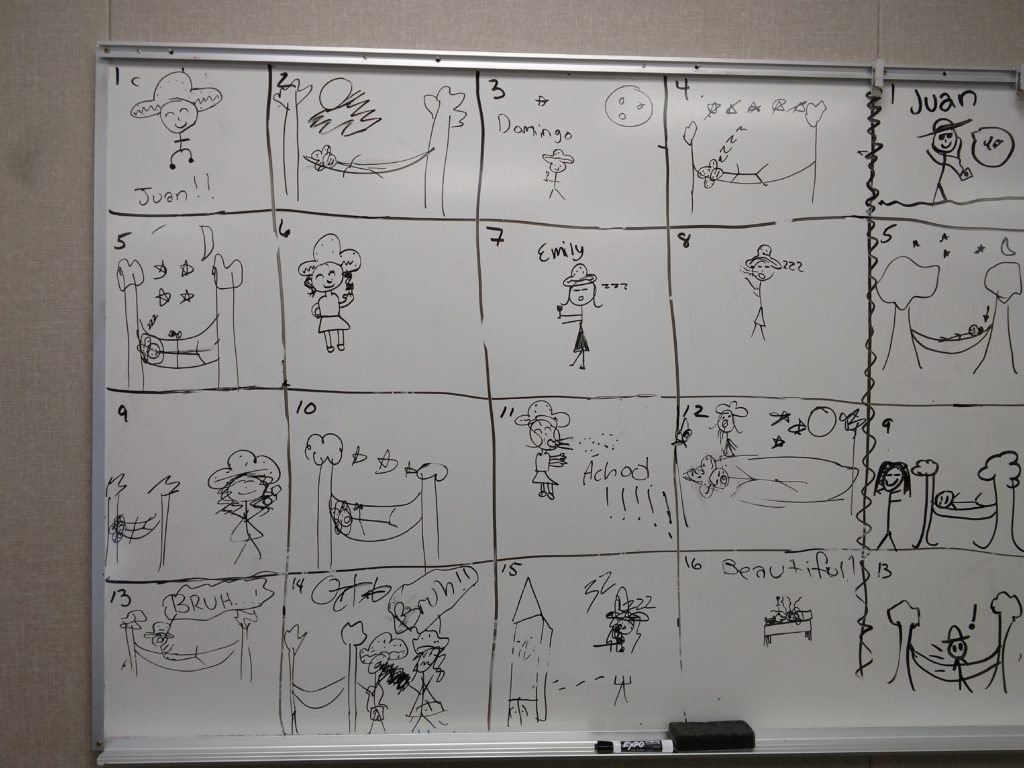I had planned this as a listening activity….but it took on a life of its own! We had asked a story the day before using some phrases from the song Hoy Es Domingo sung by Diego Torres and Ruben Blades. (Check it out if you aren’t familiar with it!)
Phrases I wanted to include were:
It was Sunday.
S/he was in bed.
S/he wanted to sleep.
Each of the three Level 2 had co-created a great story the Thursday before and I wanted to go back and review the story on Monday.
My classes are good-sized: 30-34 students and I often feel like I am herding cats trying to keep us all together going the same direction at the same time. This was a total experiment, but I loved the result!
I divided the class into four groups. Each group had 1/2 of a large white board (I have two large boards, on opposite sides of the room) They arranged their chairs (we are deskless) in a semi-circle around their particular white board section.
I had drawn a grid of 16 squares on each white board and numbered them. One student went to the board in each group. I read the first sentence from the story out loud, in Spanish, and the author had THIRTY seconds to sketch that sentence in box #1. ONLY 30 SECONDS! The group was allowed to help with meaning and ideas for the sketch. ( Rules: No criticism of artwork or interpretation allowed. Suggestions welcome. English allowed…these were middle schoolers at the beginning of level 2) )We all applauded the artists and the next student went to the board.
My plan was to go until it fell apart. (Did you ever do that with a new activity?!!) But it never did! It just kept building momentum!
What I observed:
BONDING BONDING and more BONDING! These classes are a mixture of 7th and 8th graders with a 6th grader or two mixed in. The school has nearly 1000 students. They just don’t know each other outside of my class and they really got a chance to work with new people and connect. The rules kept great artists from getting frustrated and instead made them the expert with helpful suggestions and ideas. The students that weren’t as comfortable with the language had the support of the stronger students in the group. The kids who had no confidence in their artwork had the support of their group’s ideas.
GREATER COMPREHENSION! We revisited the story with the drawing and then, we used the drawings for several follow up activities! Each time my slower processing students understood the story with more detail and my faster processors were not bored in the least. Their own artwork was intriguing!
LAUGHTER! The fact that they only had 30 seconds to draw created just enough tension to lessen the pressure for perfection. In each group (without prompting from me1) one artist added a funny detail to the picture. It might have been a funny haircut on a stick figure or a facial expression etc. Then every artist afterwards continued to use it. It started a series of laughter among students who really hadn’t known each other well.
OWNERSHIP! Each group was very proud of their ‘creation” and posed for pictures with their artwork. (These are on the school device and I’ll upload them soon!)
I’ll follow up in the next post with our follow up activities!
with love,
Laurie
